Different Roles and Characteristics of Leaders and Managers
VerifiedAdded on 2023/01/19
|10
|3023
|97
AI Summary
This report discusses the different roles and characteristics of leaders and managers in an organization. It explores the application of leader roles and managerial functions in different situational contexts. The report also covers various theories of leadership and their applications. The case study used in this report is Sainsbury, a renowned supermarket chain in the UK.
Contribute Materials
Your contribution can guide someone’s learning journey. Share your
documents today.
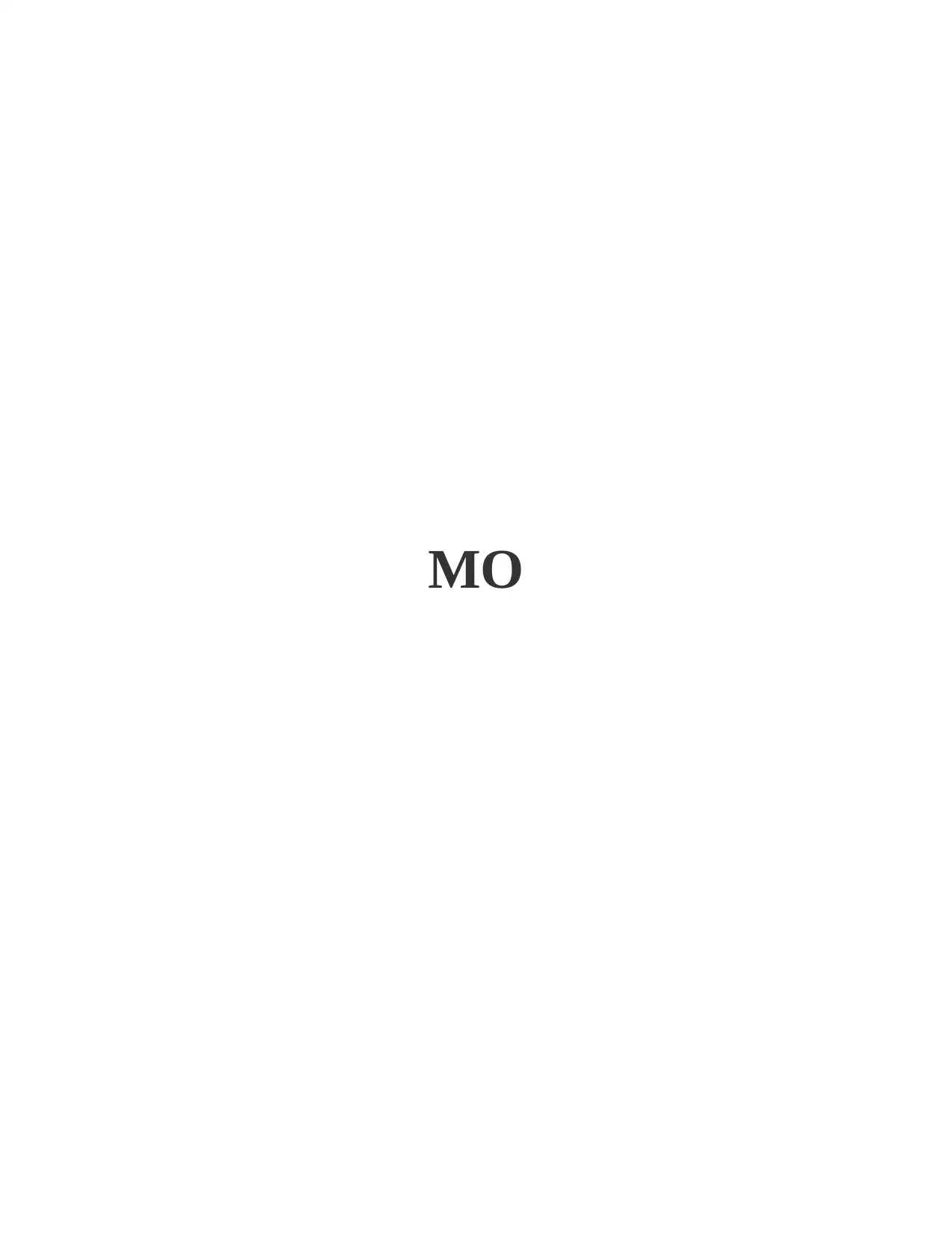
MO
Secure Best Marks with AI Grader
Need help grading? Try our AI Grader for instant feedback on your assignments.
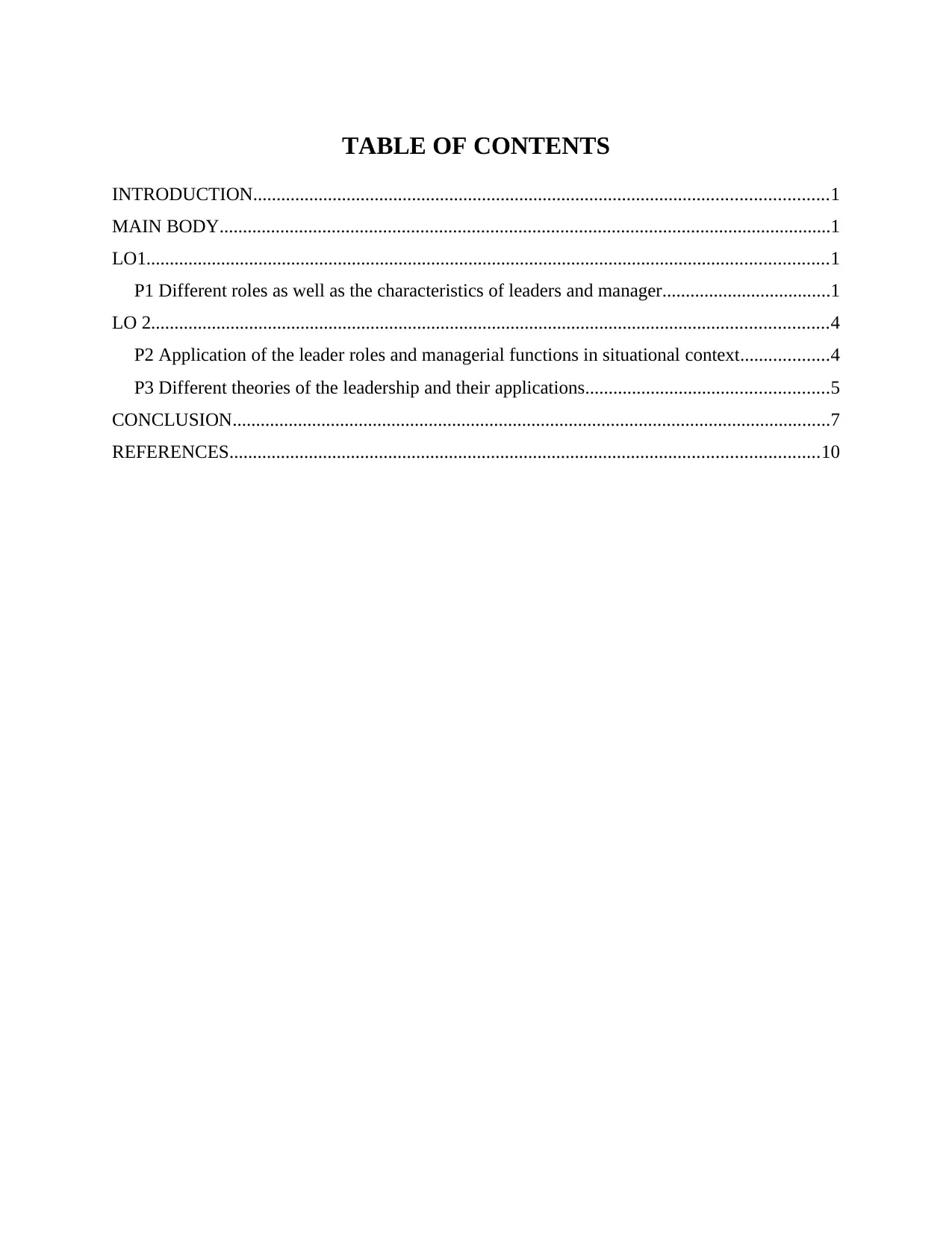
TABLE OF CONTENTS
INTRODUCTION...........................................................................................................................1
MAIN BODY...................................................................................................................................1
LO1..................................................................................................................................................1
P1 Different roles as well as the characteristics of leaders and manager....................................1
LO 2.................................................................................................................................................4
P2 Application of the leader roles and managerial functions in situational context...................4
P3 Different theories of the leadership and their applications....................................................5
CONCLUSION................................................................................................................................7
REFERENCES..............................................................................................................................10
INTRODUCTION...........................................................................................................................1
MAIN BODY...................................................................................................................................1
LO1..................................................................................................................................................1
P1 Different roles as well as the characteristics of leaders and manager....................................1
LO 2.................................................................................................................................................4
P2 Application of the leader roles and managerial functions in situational context...................4
P3 Different theories of the leadership and their applications....................................................5
CONCLUSION................................................................................................................................7
REFERENCES..............................................................................................................................10

INTRODUCTION
Management operations is predominately the administration of various business practices
in order to develop the great efficiency level which helps in attaining the goals and objectives of
the organization. Sainsbury is a renowned supermarkets chain being established by John James
Sainsbury in 1869 and placed in London, UK. It mainly incorporates Fuel stations, cafes,
supermarkets, banks, Energy etc. This report addresses the Different roles as well as the
characteristics of leaders and manager, Application of the leader roles and managerial functions
in situational context and Different theories of the leadership and their applications.
MAIN BODY
Task A
Introduction to organization
Sainsbury is a renowned supermarket chain being established by John James Sainsbury in
1869 and placed in London, UK. It mainly incorporates Fuel stations, cafes, supermarkets,
banks, Energy etc. This company is usually is divided in three divisions namely Sainsbury
Supermarkets, Sainsbury Bank, Sainsbury Argos. It is the constituent of FTSE 100 index and is
listed in London Stock Exchange.
Different roles as well as the characteristics of leaders and manager
A leader is basically the individual who is mainly involved in influencing as well as
heading the a large group of other individuals for the attainment of a specific or objective. On the
other hand, a manager is predominately the person who forms the main and essential part of any
organization and is the in charge of different departments and the tasks within an organization
(Amanchukwu, Stanley and Ololube, 2015). Although both leader and manager somewhat are
considered a the life blood of the organization and plays the similar role but still their roles and
characteristics differ in one or the other way.
Role of leader and manager
Strategist
A leader of any organization is mainly responsible for the creation of plan and thus play
the role of a strategist. They are concerned with the development of the specific goals both for
the company and well as for the employees whom they lead. They establishes the different
metrics of the performance for the evaluation of their employees in order to know whether they
haver attained their goals.
1
Management operations is predominately the administration of various business practices
in order to develop the great efficiency level which helps in attaining the goals and objectives of
the organization. Sainsbury is a renowned supermarkets chain being established by John James
Sainsbury in 1869 and placed in London, UK. It mainly incorporates Fuel stations, cafes,
supermarkets, banks, Energy etc. This report addresses the Different roles as well as the
characteristics of leaders and manager, Application of the leader roles and managerial functions
in situational context and Different theories of the leadership and their applications.
MAIN BODY
Task A
Introduction to organization
Sainsbury is a renowned supermarket chain being established by John James Sainsbury in
1869 and placed in London, UK. It mainly incorporates Fuel stations, cafes, supermarkets,
banks, Energy etc. This company is usually is divided in three divisions namely Sainsbury
Supermarkets, Sainsbury Bank, Sainsbury Argos. It is the constituent of FTSE 100 index and is
listed in London Stock Exchange.
Different roles as well as the characteristics of leaders and manager
A leader is basically the individual who is mainly involved in influencing as well as
heading the a large group of other individuals for the attainment of a specific or objective. On the
other hand, a manager is predominately the person who forms the main and essential part of any
organization and is the in charge of different departments and the tasks within an organization
(Amanchukwu, Stanley and Ololube, 2015). Although both leader and manager somewhat are
considered a the life blood of the organization and plays the similar role but still their roles and
characteristics differ in one or the other way.
Role of leader and manager
Strategist
A leader of any organization is mainly responsible for the creation of plan and thus play
the role of a strategist. They are concerned with the development of the specific goals both for
the company and well as for the employees whom they lead. They establishes the different
metrics of the performance for the evaluation of their employees in order to know whether they
haver attained their goals.
1

Communicator
A communication plays the most important role within an organization and thus is the
main emphasis of any leader. Therefore, leader plays the role of the communicator wherein they
mainly focuses on communicating the different innovative ideas to their employees as well as
listening to their opinions. They interact with their team members for relaying the different
changes which matters for the company as well as implementing the changes in the organization
by simply communicating with them through e mails, meetings etc (Nawaz and Khan_ PhD,
2016).
Role of the manager
On contrary to this, the crucial role of the manager which helps the organizations to
achieve their goals are:
Monitoring
The primary task of the manager is to receive the the various information about the
internal as well as the external events for gaining the in-depth understanding of organization thus
manager plays the role of monitor within the company (Mittal, 2015). Manager seeks data and
information through scanning their subordinates, peers etc.
Feedback
Manager also plays the role of providing feedback to their peers and their subordinates.
Managers develop the various performance metrics based on which they evaluate the
performance of their employees and thus provide them with the feedback on the key areas for
improvement. Through the feedback, managers create a culture of teamwork and thus stimulates
high level of communication in the organisation.
Characteristics of the leaders
Honesty as well as integrity
An effective leader has the quality of being honest along with the integrity. A good leader
mainly focuses on building the high level of trust within their employees and throughout the
organization. This forms the paramount for every organization. An effective leader are not
sceptical regarding their visions and missions and hence shows great transparency and honesty
while conducting their work.
2
A communication plays the most important role within an organization and thus is the
main emphasis of any leader. Therefore, leader plays the role of the communicator wherein they
mainly focuses on communicating the different innovative ideas to their employees as well as
listening to their opinions. They interact with their team members for relaying the different
changes which matters for the company as well as implementing the changes in the organization
by simply communicating with them through e mails, meetings etc (Nawaz and Khan_ PhD,
2016).
Role of the manager
On contrary to this, the crucial role of the manager which helps the organizations to
achieve their goals are:
Monitoring
The primary task of the manager is to receive the the various information about the
internal as well as the external events for gaining the in-depth understanding of organization thus
manager plays the role of monitor within the company (Mittal, 2015). Manager seeks data and
information through scanning their subordinates, peers etc.
Feedback
Manager also plays the role of providing feedback to their peers and their subordinates.
Managers develop the various performance metrics based on which they evaluate the
performance of their employees and thus provide them with the feedback on the key areas for
improvement. Through the feedback, managers create a culture of teamwork and thus stimulates
high level of communication in the organisation.
Characteristics of the leaders
Honesty as well as integrity
An effective leader has the quality of being honest along with the integrity. A good leader
mainly focuses on building the high level of trust within their employees and throughout the
organization. This forms the paramount for every organization. An effective leader are not
sceptical regarding their visions and missions and hence shows great transparency and honesty
while conducting their work.
2
Secure Best Marks with AI Grader
Need help grading? Try our AI Grader for instant feedback on your assignments.
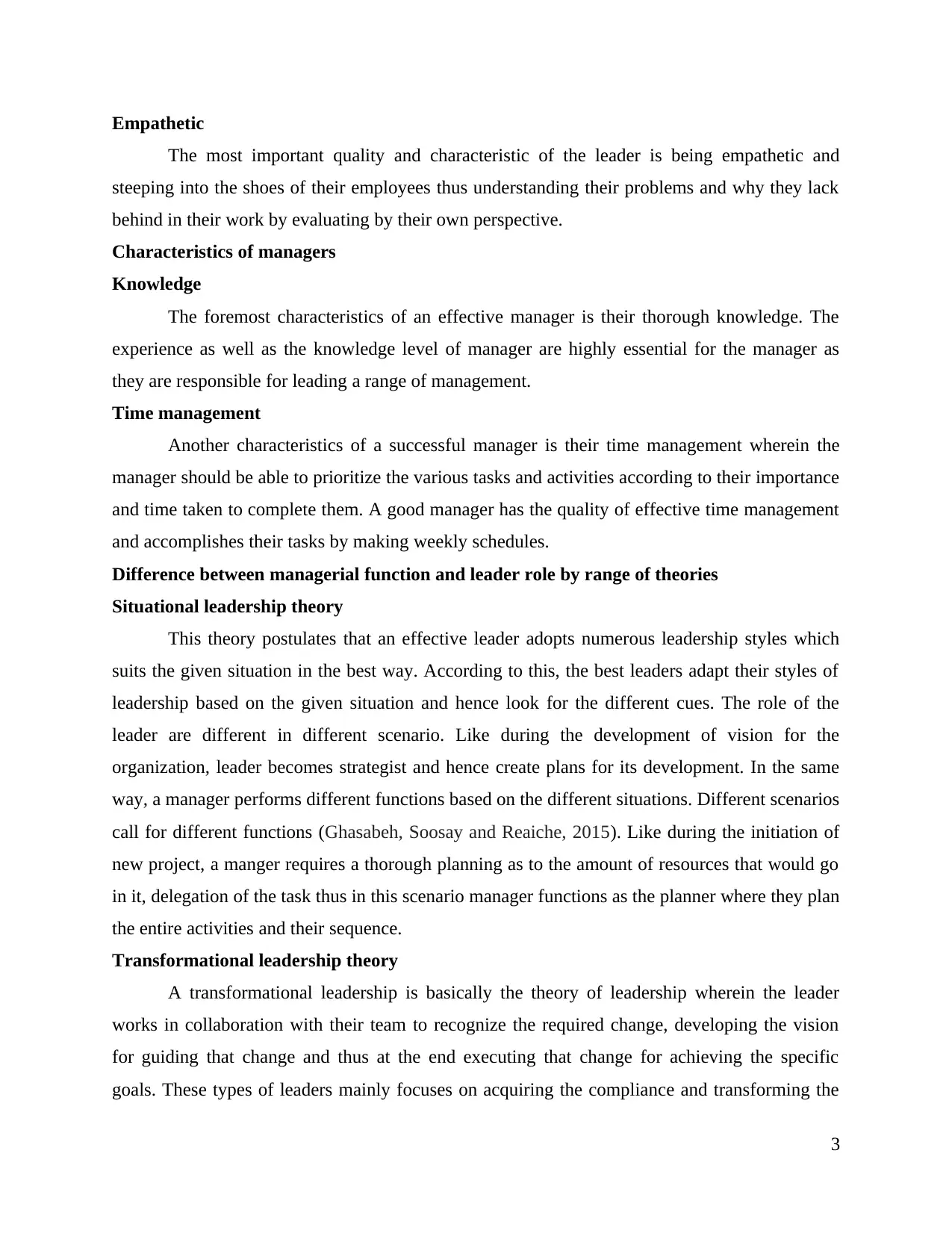
Empathetic
The most important quality and characteristic of the leader is being empathetic and
steeping into the shoes of their employees thus understanding their problems and why they lack
behind in their work by evaluating by their own perspective.
Characteristics of managers
Knowledge
The foremost characteristics of an effective manager is their thorough knowledge. The
experience as well as the knowledge level of manager are highly essential for the manager as
they are responsible for leading a range of management.
Time management
Another characteristics of a successful manager is their time management wherein the
manager should be able to prioritize the various tasks and activities according to their importance
and time taken to complete them. A good manager has the quality of effective time management
and accomplishes their tasks by making weekly schedules.
Difference between managerial function and leader role by range of theories
Situational leadership theory
This theory postulates that an effective leader adopts numerous leadership styles which
suits the given situation in the best way. According to this, the best leaders adapt their styles of
leadership based on the given situation and hence look for the different cues. The role of the
leader are different in different scenario. Like during the development of vision for the
organization, leader becomes strategist and hence create plans for its development. In the same
way, a manager performs different functions based on the different situations. Different scenarios
call for different functions (Ghasabeh, Soosay and Reaiche, 2015). Like during the initiation of
new project, a manger requires a thorough planning as to the amount of resources that would go
in it, delegation of the task thus in this scenario manager functions as the planner where they plan
the entire activities and their sequence.
Transformational leadership theory
A transformational leadership is basically the theory of leadership wherein the leader
works in collaboration with their team to recognize the required change, developing the vision
for guiding that change and thus at the end executing that change for achieving the specific
goals. These types of leaders mainly focuses on acquiring the compliance and transforming the
3
The most important quality and characteristic of the leader is being empathetic and
steeping into the shoes of their employees thus understanding their problems and why they lack
behind in their work by evaluating by their own perspective.
Characteristics of managers
Knowledge
The foremost characteristics of an effective manager is their thorough knowledge. The
experience as well as the knowledge level of manager are highly essential for the manager as
they are responsible for leading a range of management.
Time management
Another characteristics of a successful manager is their time management wherein the
manager should be able to prioritize the various tasks and activities according to their importance
and time taken to complete them. A good manager has the quality of effective time management
and accomplishes their tasks by making weekly schedules.
Difference between managerial function and leader role by range of theories
Situational leadership theory
This theory postulates that an effective leader adopts numerous leadership styles which
suits the given situation in the best way. According to this, the best leaders adapt their styles of
leadership based on the given situation and hence look for the different cues. The role of the
leader are different in different scenario. Like during the development of vision for the
organization, leader becomes strategist and hence create plans for its development. In the same
way, a manager performs different functions based on the different situations. Different scenarios
call for different functions (Ghasabeh, Soosay and Reaiche, 2015). Like during the initiation of
new project, a manger requires a thorough planning as to the amount of resources that would go
in it, delegation of the task thus in this scenario manager functions as the planner where they plan
the entire activities and their sequence.
Transformational leadership theory
A transformational leadership is basically the theory of leadership wherein the leader
works in collaboration with their team to recognize the required change, developing the vision
for guiding that change and thus at the end executing that change for achieving the specific
goals. These types of leaders mainly focuses on acquiring the compliance and transforming the
3
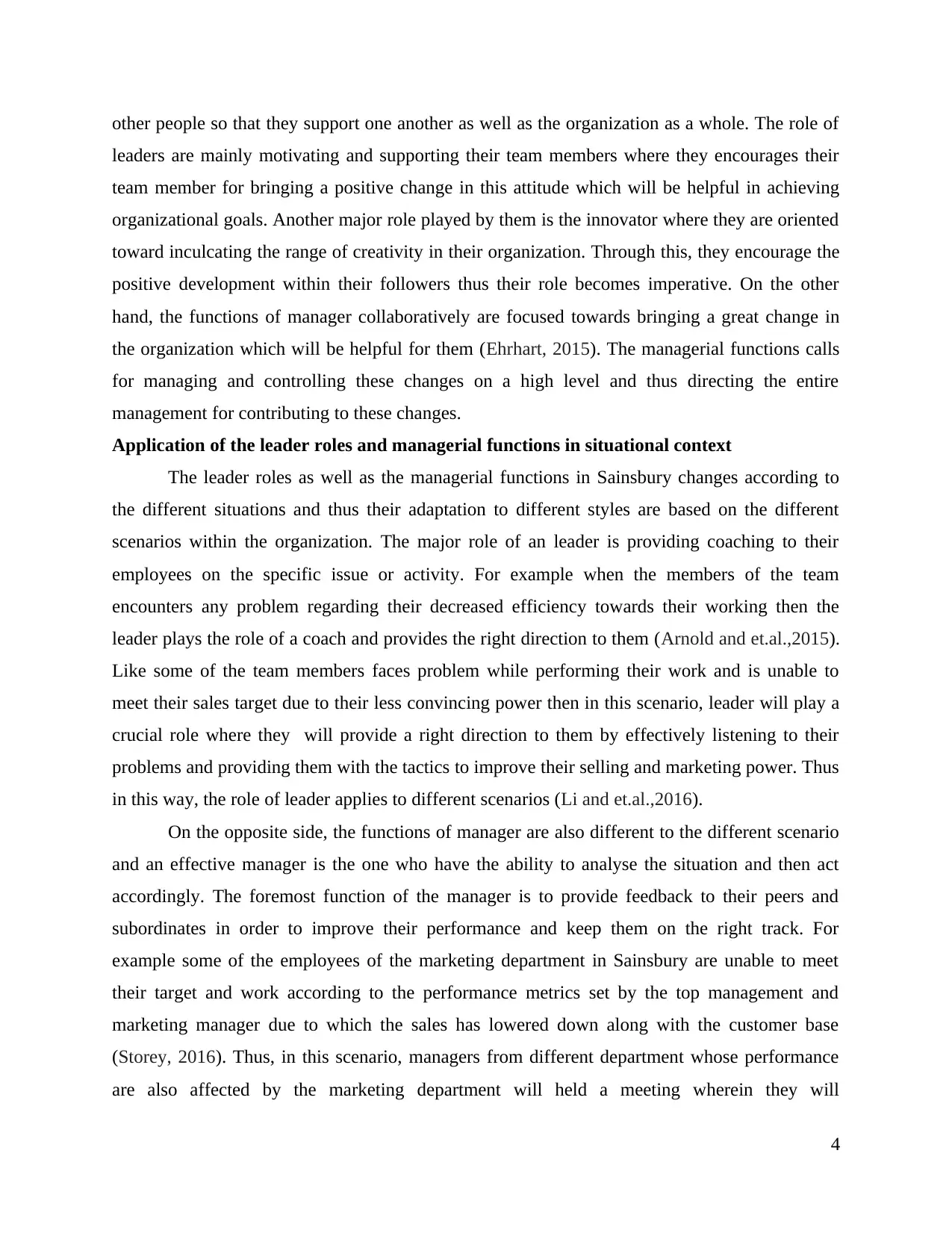
other people so that they support one another as well as the organization as a whole. The role of
leaders are mainly motivating and supporting their team members where they encourages their
team member for bringing a positive change in this attitude which will be helpful in achieving
organizational goals. Another major role played by them is the innovator where they are oriented
toward inculcating the range of creativity in their organization. Through this, they encourage the
positive development within their followers thus their role becomes imperative. On the other
hand, the functions of manager collaboratively are focused towards bringing a great change in
the organization which will be helpful for them (Ehrhart, 2015). The managerial functions calls
for managing and controlling these changes on a high level and thus directing the entire
management for contributing to these changes.
Application of the leader roles and managerial functions in situational context
The leader roles as well as the managerial functions in Sainsbury changes according to
the different situations and thus their adaptation to different styles are based on the different
scenarios within the organization. The major role of an leader is providing coaching to their
employees on the specific issue or activity. For example when the members of the team
encounters any problem regarding their decreased efficiency towards their working then the
leader plays the role of a coach and provides the right direction to them (Arnold and et.al.,2015).
Like some of the team members faces problem while performing their work and is unable to
meet their sales target due to their less convincing power then in this scenario, leader will play a
crucial role where they will provide a right direction to them by effectively listening to their
problems and providing them with the tactics to improve their selling and marketing power. Thus
in this way, the role of leader applies to different scenarios (Li and et.al.,2016).
On the opposite side, the functions of manager are also different to the different scenario
and an effective manager is the one who have the ability to analyse the situation and then act
accordingly. The foremost function of the manager is to provide feedback to their peers and
subordinates in order to improve their performance and keep them on the right track. For
example some of the employees of the marketing department in Sainsbury are unable to meet
their target and work according to the performance metrics set by the top management and
marketing manager due to which the sales has lowered down along with the customer base
(Storey, 2016). Thus, in this scenario, managers from different department whose performance
are also affected by the marketing department will held a meeting wherein they will
4
leaders are mainly motivating and supporting their team members where they encourages their
team member for bringing a positive change in this attitude which will be helpful in achieving
organizational goals. Another major role played by them is the innovator where they are oriented
toward inculcating the range of creativity in their organization. Through this, they encourage the
positive development within their followers thus their role becomes imperative. On the other
hand, the functions of manager collaboratively are focused towards bringing a great change in
the organization which will be helpful for them (Ehrhart, 2015). The managerial functions calls
for managing and controlling these changes on a high level and thus directing the entire
management for contributing to these changes.
Application of the leader roles and managerial functions in situational context
The leader roles as well as the managerial functions in Sainsbury changes according to
the different situations and thus their adaptation to different styles are based on the different
scenarios within the organization. The major role of an leader is providing coaching to their
employees on the specific issue or activity. For example when the members of the team
encounters any problem regarding their decreased efficiency towards their working then the
leader plays the role of a coach and provides the right direction to them (Arnold and et.al.,2015).
Like some of the team members faces problem while performing their work and is unable to
meet their sales target due to their less convincing power then in this scenario, leader will play a
crucial role where they will provide a right direction to them by effectively listening to their
problems and providing them with the tactics to improve their selling and marketing power. Thus
in this way, the role of leader applies to different scenarios (Li and et.al.,2016).
On the opposite side, the functions of manager are also different to the different scenario
and an effective manager is the one who have the ability to analyse the situation and then act
accordingly. The foremost function of the manager is to provide feedback to their peers and
subordinates in order to improve their performance and keep them on the right track. For
example some of the employees of the marketing department in Sainsbury are unable to meet
their target and work according to the performance metrics set by the top management and
marketing manager due to which the sales has lowered down along with the customer base
(Storey, 2016). Thus, in this scenario, managers from different department whose performance
are also affected by the marketing department will held a meeting wherein they will
4
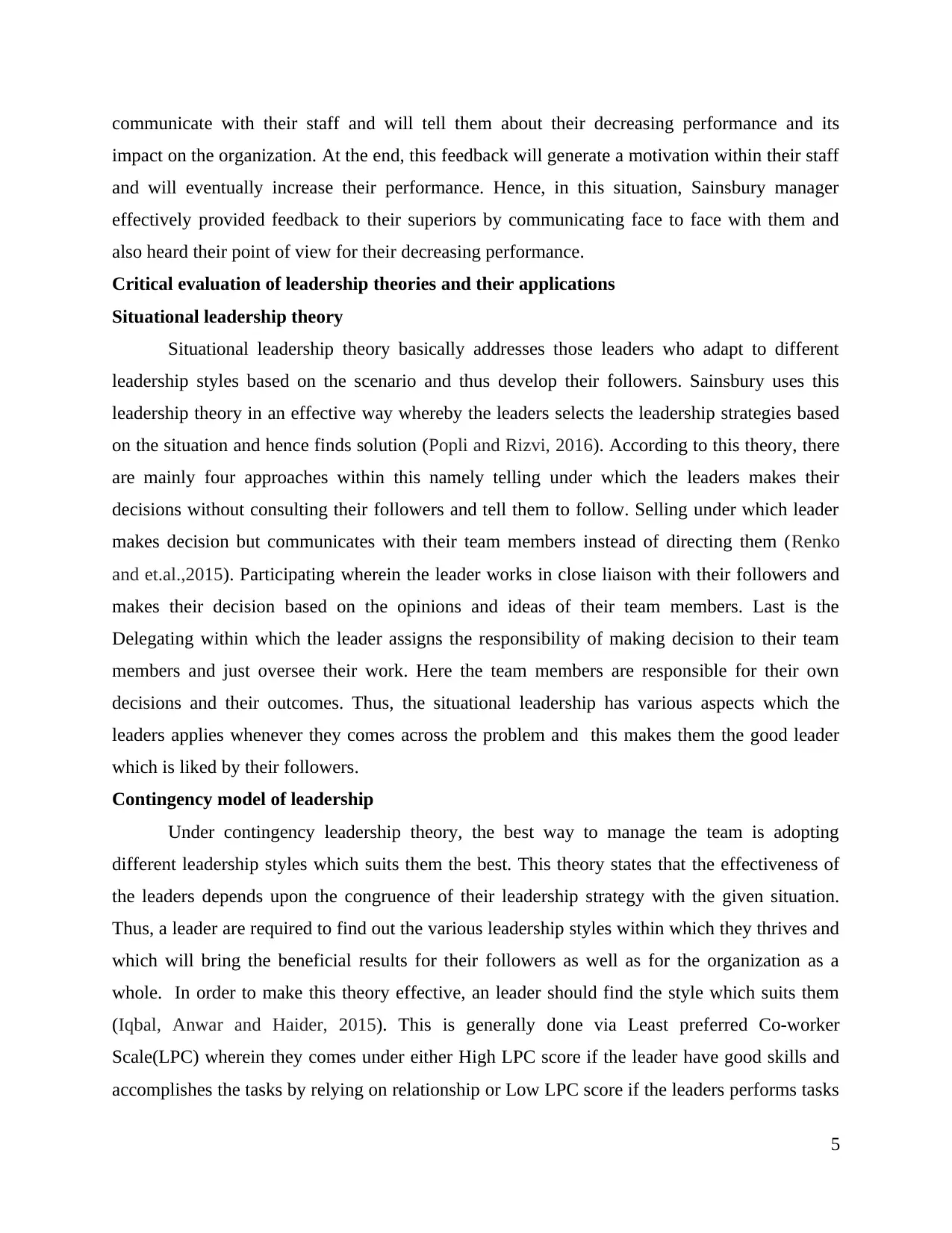
communicate with their staff and will tell them about their decreasing performance and its
impact on the organization. At the end, this feedback will generate a motivation within their staff
and will eventually increase their performance. Hence, in this situation, Sainsbury manager
effectively provided feedback to their superiors by communicating face to face with them and
also heard their point of view for their decreasing performance.
Critical evaluation of leadership theories and their applications
Situational leadership theory
Situational leadership theory basically addresses those leaders who adapt to different
leadership styles based on the scenario and thus develop their followers. Sainsbury uses this
leadership theory in an effective way whereby the leaders selects the leadership strategies based
on the situation and hence finds solution (Popli and Rizvi, 2016). According to this theory, there
are mainly four approaches within this namely telling under which the leaders makes their
decisions without consulting their followers and tell them to follow. Selling under which leader
makes decision but communicates with their team members instead of directing them (Renko
and et.al.,2015). Participating wherein the leader works in close liaison with their followers and
makes their decision based on the opinions and ideas of their team members. Last is the
Delegating within which the leader assigns the responsibility of making decision to their team
members and just oversee their work. Here the team members are responsible for their own
decisions and their outcomes. Thus, the situational leadership has various aspects which the
leaders applies whenever they comes across the problem and this makes them the good leader
which is liked by their followers.
Contingency model of leadership
Under contingency leadership theory, the best way to manage the team is adopting
different leadership styles which suits them the best. This theory states that the effectiveness of
the leaders depends upon the congruence of their leadership strategy with the given situation.
Thus, a leader are required to find out the various leadership styles within which they thrives and
which will bring the beneficial results for their followers as well as for the organization as a
whole. In order to make this theory effective, an leader should find the style which suits them
(Iqbal, Anwar and Haider, 2015). This is generally done via Least preferred Co-worker
Scale(LPC) wherein they comes under either High LPC score if the leader have good skills and
accomplishes the tasks by relying on relationship or Low LPC score if the leaders performs tasks
5
impact on the organization. At the end, this feedback will generate a motivation within their staff
and will eventually increase their performance. Hence, in this situation, Sainsbury manager
effectively provided feedback to their superiors by communicating face to face with them and
also heard their point of view for their decreasing performance.
Critical evaluation of leadership theories and their applications
Situational leadership theory
Situational leadership theory basically addresses those leaders who adapt to different
leadership styles based on the scenario and thus develop their followers. Sainsbury uses this
leadership theory in an effective way whereby the leaders selects the leadership strategies based
on the situation and hence finds solution (Popli and Rizvi, 2016). According to this theory, there
are mainly four approaches within this namely telling under which the leaders makes their
decisions without consulting their followers and tell them to follow. Selling under which leader
makes decision but communicates with their team members instead of directing them (Renko
and et.al.,2015). Participating wherein the leader works in close liaison with their followers and
makes their decision based on the opinions and ideas of their team members. Last is the
Delegating within which the leader assigns the responsibility of making decision to their team
members and just oversee their work. Here the team members are responsible for their own
decisions and their outcomes. Thus, the situational leadership has various aspects which the
leaders applies whenever they comes across the problem and this makes them the good leader
which is liked by their followers.
Contingency model of leadership
Under contingency leadership theory, the best way to manage the team is adopting
different leadership styles which suits them the best. This theory states that the effectiveness of
the leaders depends upon the congruence of their leadership strategy with the given situation.
Thus, a leader are required to find out the various leadership styles within which they thrives and
which will bring the beneficial results for their followers as well as for the organization as a
whole. In order to make this theory effective, an leader should find the style which suits them
(Iqbal, Anwar and Haider, 2015). This is generally done via Least preferred Co-worker
Scale(LPC) wherein they comes under either High LPC score if the leader have good skills and
accomplishes the tasks by relying on relationship or Low LPC score if the leaders performs tasks
5
Paraphrase This Document
Need a fresh take? Get an instant paraphrase of this document with our AI Paraphraser
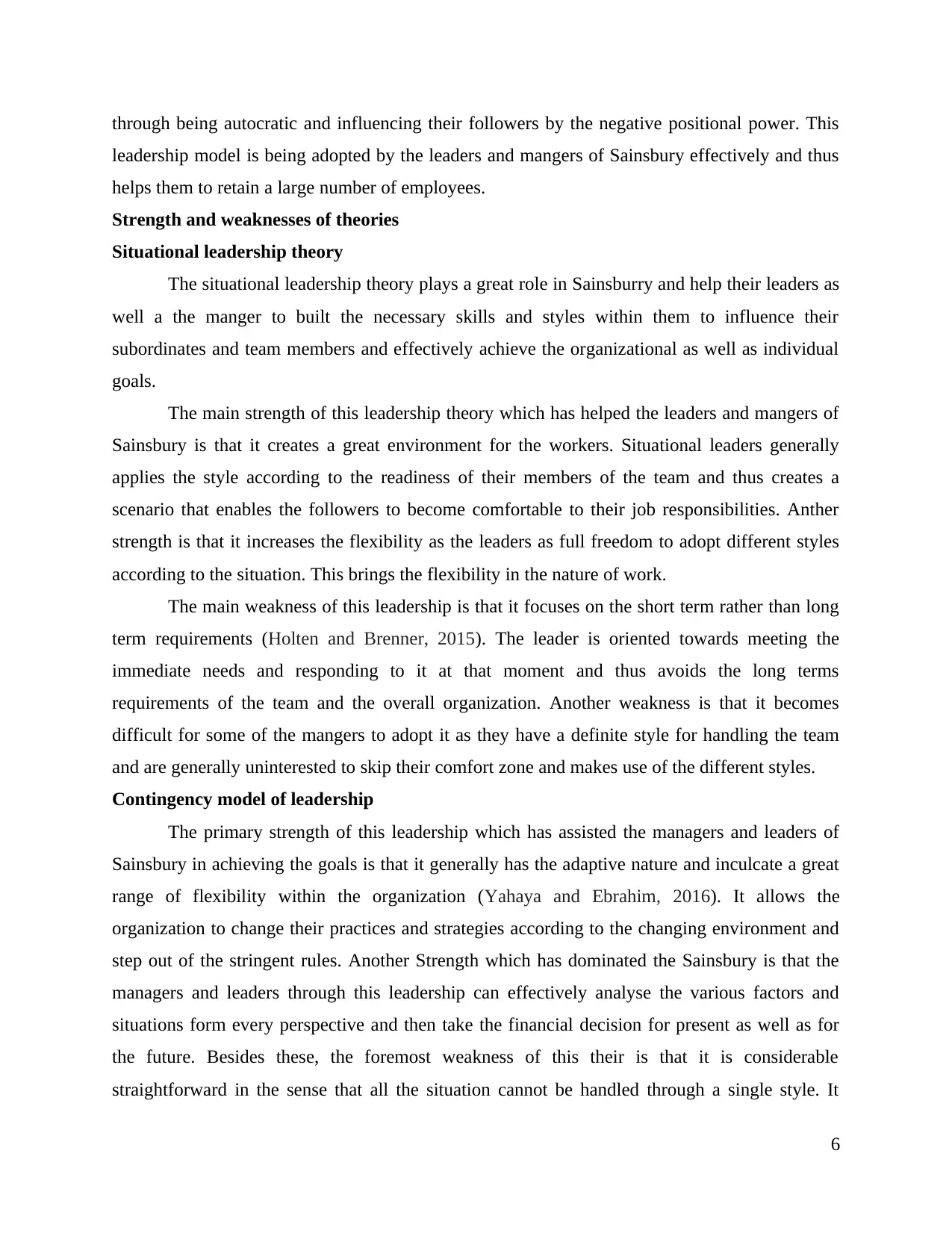
through being autocratic and influencing their followers by the negative positional power. This
leadership model is being adopted by the leaders and mangers of Sainsbury effectively and thus
helps them to retain a large number of employees.
Strength and weaknesses of theories
Situational leadership theory
The situational leadership theory plays a great role in Sainsburry and help their leaders as
well a the manger to built the necessary skills and styles within them to influence their
subordinates and team members and effectively achieve the organizational as well as individual
goals.
The main strength of this leadership theory which has helped the leaders and mangers of
Sainsbury is that it creates a great environment for the workers. Situational leaders generally
applies the style according to the readiness of their members of the team and thus creates a
scenario that enables the followers to become comfortable to their job responsibilities. Anther
strength is that it increases the flexibility as the leaders as full freedom to adopt different styles
according to the situation. This brings the flexibility in the nature of work.
The main weakness of this leadership is that it focuses on the short term rather than long
term requirements (Holten and Brenner, 2015). The leader is oriented towards meeting the
immediate needs and responding to it at that moment and thus avoids the long terms
requirements of the team and the overall organization. Another weakness is that it becomes
difficult for some of the mangers to adopt it as they have a definite style for handling the team
and are generally uninterested to skip their comfort zone and makes use of the different styles.
Contingency model of leadership
The primary strength of this leadership which has assisted the managers and leaders of
Sainsbury in achieving the goals is that it generally has the adaptive nature and inculcate a great
range of flexibility within the organization (Yahaya and Ebrahim, 2016). It allows the
organization to change their practices and strategies according to the changing environment and
step out of the stringent rules. Another Strength which has dominated the Sainsbury is that the
managers and leaders through this leadership can effectively analyse the various factors and
situations form every perspective and then take the financial decision for present as well as for
the future. Besides these, the foremost weakness of this their is that it is considerable
straightforward in the sense that all the situation cannot be handled through a single style. It
6
leadership model is being adopted by the leaders and mangers of Sainsbury effectively and thus
helps them to retain a large number of employees.
Strength and weaknesses of theories
Situational leadership theory
The situational leadership theory plays a great role in Sainsburry and help their leaders as
well a the manger to built the necessary skills and styles within them to influence their
subordinates and team members and effectively achieve the organizational as well as individual
goals.
The main strength of this leadership theory which has helped the leaders and mangers of
Sainsbury is that it creates a great environment for the workers. Situational leaders generally
applies the style according to the readiness of their members of the team and thus creates a
scenario that enables the followers to become comfortable to their job responsibilities. Anther
strength is that it increases the flexibility as the leaders as full freedom to adopt different styles
according to the situation. This brings the flexibility in the nature of work.
The main weakness of this leadership is that it focuses on the short term rather than long
term requirements (Holten and Brenner, 2015). The leader is oriented towards meeting the
immediate needs and responding to it at that moment and thus avoids the long terms
requirements of the team and the overall organization. Another weakness is that it becomes
difficult for some of the mangers to adopt it as they have a definite style for handling the team
and are generally uninterested to skip their comfort zone and makes use of the different styles.
Contingency model of leadership
The primary strength of this leadership which has assisted the managers and leaders of
Sainsbury in achieving the goals is that it generally has the adaptive nature and inculcate a great
range of flexibility within the organization (Yahaya and Ebrahim, 2016). It allows the
organization to change their practices and strategies according to the changing environment and
step out of the stringent rules. Another Strength which has dominated the Sainsbury is that the
managers and leaders through this leadership can effectively analyse the various factors and
situations form every perspective and then take the financial decision for present as well as for
the future. Besides these, the foremost weakness of this their is that it is considerable
straightforward in the sense that all the situation cannot be handled through a single style. It
6
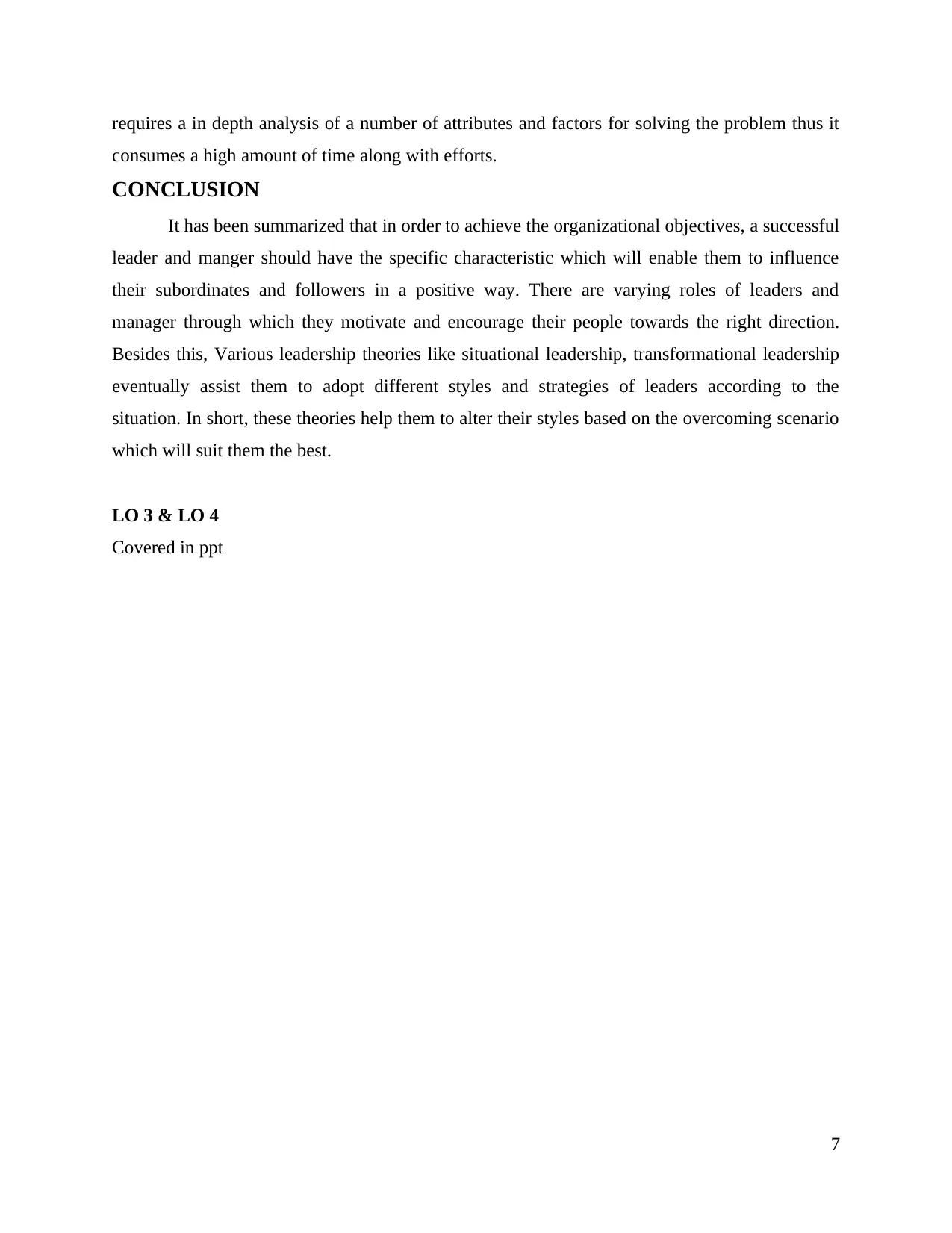
requires a in depth analysis of a number of attributes and factors for solving the problem thus it
consumes a high amount of time along with efforts.
CONCLUSION
It has been summarized that in order to achieve the organizational objectives, a successful
leader and manger should have the specific characteristic which will enable them to influence
their subordinates and followers in a positive way. There are varying roles of leaders and
manager through which they motivate and encourage their people towards the right direction.
Besides this, Various leadership theories like situational leadership, transformational leadership
eventually assist them to adopt different styles and strategies of leaders according to the
situation. In short, these theories help them to alter their styles based on the overcoming scenario
which will suit them the best.
LO 3 & LO 4
Covered in ppt
7
consumes a high amount of time along with efforts.
CONCLUSION
It has been summarized that in order to achieve the organizational objectives, a successful
leader and manger should have the specific characteristic which will enable them to influence
their subordinates and followers in a positive way. There are varying roles of leaders and
manager through which they motivate and encourage their people towards the right direction.
Besides this, Various leadership theories like situational leadership, transformational leadership
eventually assist them to adopt different styles and strategies of leaders according to the
situation. In short, these theories help them to alter their styles based on the overcoming scenario
which will suit them the best.
LO 3 & LO 4
Covered in ppt
7

REFERENCES
Books and Journals
Amanchukwu, R.N., Stanley, G.J. and Ololube, N.P., 2015. A review of leadership theories,
principles and styles and their relevance to educational management. Management.5(1).
pp.6-14.
Arnold, K.A and et.al.,2015. Leadership styles, emotion regulation, and burnout. Journal of
Occupational Health Psychology.20(4). p.481.
Ehrhart, M.G., 2015. Self-concept, implicit leadership theories, and follower preferences for
leadership. Zeitschrift für Psychologie.
Ghasabeh, M.S., Soosay, C. and Reaiche, C., 2015. The emerging role of transformational
leadership. The Journal of Developing Areas.49(6). pp.459-467.
Holten, A.L. and Brenner, S.O., 2015. Leadership style and the process of organizational
change. Leadership & Organization Development Journal.36(1). pp.2-16.
Iqbal, N., Anwar, S. and Haider, N., 2015. Effect of leadership style on employee
performance. Arabian Journal of Business and Management Review.5(5). pp.1-6.
Li, Z and et.al.,2016. Combinative aspects of leadership style and emotional
intelligence.Leadership & Organization Development Journal.37(1). pp.107-125.
Mittal, R., 2015. Charismatic and transformational leadership styles: A cross-cultural
perspective. International Journal of Business and Management.10(3). p.26.
Nawaz, Z.A.K.D.A. and Khan_ PhD, I., 2016. Leadership theories and styles: A literature
review. Leadership.16. pp.1-7.
Popli, S. and Rizvi, I.A., 2016. Drivers of employee engagement: The role of leadership
style. Global Business Review.17(4). pp.965-979.
Renko, M and et.al.,2015. Understanding and measuring entrepreneurial leadership style. Journal
of Small Business Management.53(1). pp.54-74.
Storey, J., 2016. Changing theories of leadership and leadership development. In Leadership in
Organizations (pp. 17-41). Routledge.
Yahaya, R. and Ebrahim, F., 2016. Leadership styles and organizational commitment: literature
review. Journal of Management Development.35(2). pp.190-216.
8
Books and Journals
Amanchukwu, R.N., Stanley, G.J. and Ololube, N.P., 2015. A review of leadership theories,
principles and styles and their relevance to educational management. Management.5(1).
pp.6-14.
Arnold, K.A and et.al.,2015. Leadership styles, emotion regulation, and burnout. Journal of
Occupational Health Psychology.20(4). p.481.
Ehrhart, M.G., 2015. Self-concept, implicit leadership theories, and follower preferences for
leadership. Zeitschrift für Psychologie.
Ghasabeh, M.S., Soosay, C. and Reaiche, C., 2015. The emerging role of transformational
leadership. The Journal of Developing Areas.49(6). pp.459-467.
Holten, A.L. and Brenner, S.O., 2015. Leadership style and the process of organizational
change. Leadership & Organization Development Journal.36(1). pp.2-16.
Iqbal, N., Anwar, S. and Haider, N., 2015. Effect of leadership style on employee
performance. Arabian Journal of Business and Management Review.5(5). pp.1-6.
Li, Z and et.al.,2016. Combinative aspects of leadership style and emotional
intelligence.Leadership & Organization Development Journal.37(1). pp.107-125.
Mittal, R., 2015. Charismatic and transformational leadership styles: A cross-cultural
perspective. International Journal of Business and Management.10(3). p.26.
Nawaz, Z.A.K.D.A. and Khan_ PhD, I., 2016. Leadership theories and styles: A literature
review. Leadership.16. pp.1-7.
Popli, S. and Rizvi, I.A., 2016. Drivers of employee engagement: The role of leadership
style. Global Business Review.17(4). pp.965-979.
Renko, M and et.al.,2015. Understanding and measuring entrepreneurial leadership style. Journal
of Small Business Management.53(1). pp.54-74.
Storey, J., 2016. Changing theories of leadership and leadership development. In Leadership in
Organizations (pp. 17-41). Routledge.
Yahaya, R. and Ebrahim, F., 2016. Leadership styles and organizational commitment: literature
review. Journal of Management Development.35(2). pp.190-216.
8
1 out of 10
Related Documents
Your All-in-One AI-Powered Toolkit for Academic Success.
+13062052269
info@desklib.com
Available 24*7 on WhatsApp / Email
![[object Object]](/_next/static/media/star-bottom.7253800d.svg)
Unlock your academic potential
© 2024 | Zucol Services PVT LTD | All rights reserved.





